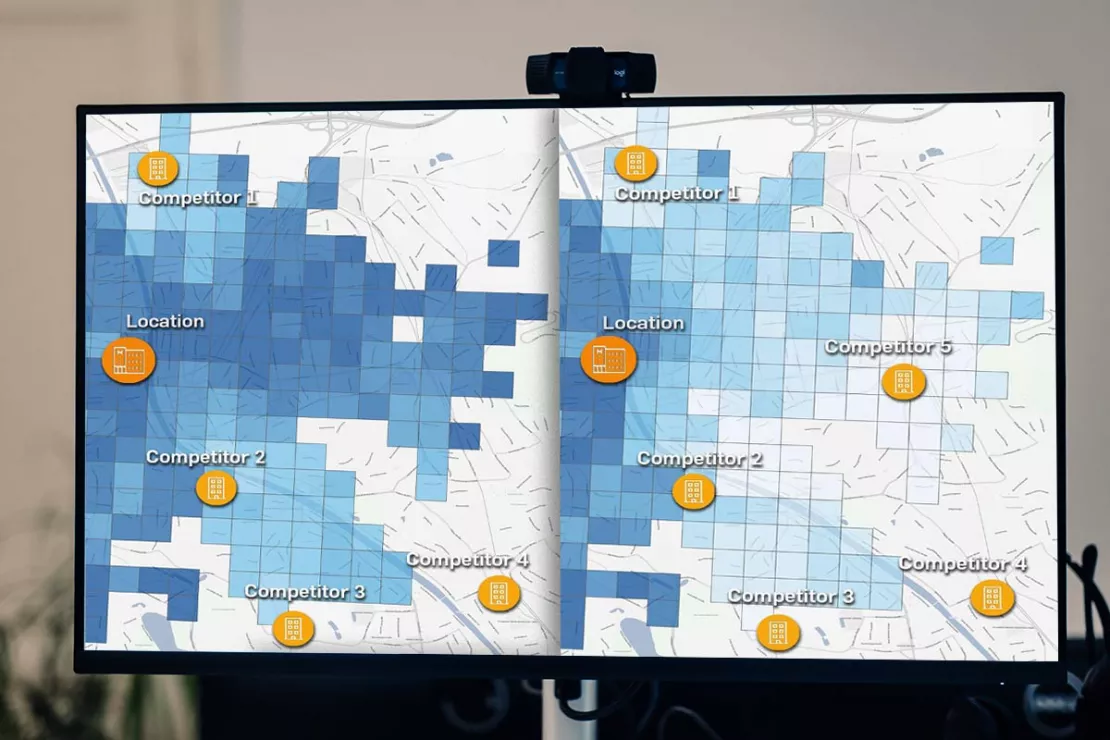Current Geomarketing Trends in Retail
Trends such as big data, omnichannel, and customized online GIS tools are still incredibly popular. There are new developments regarding the complexity of location analyses, the use of internal company data, and the increasing use of AI in GIS. An overview of the most important geomarketing trends!
What are the current geomarketing trends in retail?
The following trends are currently shaping geomarketing and GIS for retail:
- Complex location analyses
- Omnichannel
- AI in geomarketing software
- Customizable geomarketing software
- Big Data and proprietary data sources.
Do you have questions about geomarketing trends in retail? We are happy to help you!
The Five Geomarketing Trends in Retail
Retail is undergoing rapid changes unlike any other industry. In 2025, retail is currently facing major challenges, but also exciting opportunities. Geomarketing and location intelligence play a central role in making data-driven decisions and remaining competitive.
Here are the five most important geomarketing trends shaping retail this year.
Trend 1: Complex Location Analyses
The importance of complex location analyses in retail is growing. Constantly rising rental and ancillary costs, as well as price pressure from online retailers, are making it increasingly difficult for brick-and-mortar retailers to find economically viable space. It is essential to perform a detailed risk-opportunity assessment for a location before entering into a long-term lease. Geomarketing analyses make it possible to predict the long-term development and profitability of a location. This can be done for example with the help of location-specific sales forecasts. This is only possible with complex analysis models, such as a gravity analysis. To ensure the long-term success of a location, retailers are increasingly adapting their product range to the specific characteristics of their surroundings. Branch network restructuring is also gaining in importance. Two questions play a central role for retailers: How many branches are necessary? Where do these locations have to be positioned to maximize demand potential? Simulation analyses can answer such questions.

“A well-designed geoanalysis greatly improves the quality of a location assessment, allowing you to make better decisions. We see a clear trend towards greater complexity here. For many, sales or success forecasts using gravity models are already “state-of-the-art”. This is understandable, because some markets are showing a certain degree of saturation, cost pressure is immense, and consumer behavior is complex, making well-positioned location networks necessary to ensure productivity is optimized in the area.”
Renate Dumberger, Senior Manager, WIGeoGIS
Trend 2: Artificial Intelligence (AI) in GIS Software
The topic of artificial intelligence is also being addressed in the area of geomarketing and GIS software. The combination of artificial intelligence (AI) and geographic information systems (GIS) opens up completely new geomarketing opportunities for retailers. AI-supported algorithms make it possible to evaluate huge amounts of location and movement data in real time, providing a strong basis for forecasts for location planning.
For example, there are tools that use AI to analyze millions of points of interest (POIs) and visualize them in interactive maps to identify optimal locations. An AI tool for location analysis created by WIGeoGIS is WIGeo Location Atlas. Marc Urner, Head of the Project, explains: “We developed an AI that independently categorizes POI data based on semantic patterns and derives precise location factors through targeted refinement.”
In addition, store locator data can be analyzed using AI, and patterns can be identified that can be used for location planning, marketing campaigns, and product strategies.
Another use case is the identification of regions with untapped potential: AI can predict where new branches would be profitable and where existing locations can be strengthened through targeted measures. In addition, personalized marketing campaigns can be developed by combining AI customer data with location preferences. This allows retailers to send offers or discounts to customers who are interested in specific stores.
Another use of AI in geomarketing relates to AI-based image and text analysis to identify businesses from street images and assign them to precise categories.
The symbiosis of AI and GIS makes geomarketing more efficient, data-driven, and future-proof, which provides a decisive advantage for retailers.
Trend 3: Omnichannel
Retailers face the challenge of creating seamless online and offline experiences. The implementation of omnichannel strategies is often difficult due to insufficiently integrated systems and inventory discrepancies. In addition to this, it is a challenge to coordinate online and brick-and-mortar retail effectively.
Therefore, retail companies are increasingly evaluating data from web shops and online sales geographically. This provides them with insights into which groups of people are more likely to become online shoppers or customers in brick-and-mortar stores, and where they can be found. The results of the geomarketing analyses flow into the planning of marketing campaigns and branch locations. For example, particularly high online sales or returns in a certain area and many inquiries in the branch finder based on addresses or ZIP Codes can provide clues as to where it is worthwhile to open a new location.
Trend 4: Customizable Geomarketing Software
The possibility of adapting geomarketing software to the exact needs of a company is becoming increasingly important. Business models, sales channels, and data sources are becoming increasingly complex and individual. In addition, marketing campaigns are increasingly moving towards personalization, which requires detailed data. Due to these developments, retail companies want a geomarketing software that can be used collaboratively and is suitable for various purposes and departments (expansion, location and product range planning, controlling, sales, marketing, advertising distribution, management). Collaborative use also requires a rights and roles concept that fits the company structure. Read and write permissions are regulated according to the different areas and hierarchical levels.
Web-based GIS solutions enable access to a uniform database, making decision-making processes more efficient. A modular software structure ensures that changes resulting from new strategies, new target groups, or locations can be reflected promptly. Necessary functions such as location analyses and reporting are thus quickly available even when conditions have changed.
“In the future, the customizability of geomarketing software must go beyond simply importing your own company data and offer special analyses tailored to the needs of the company.”
Renate Dumberger, Senior Manager, WIGeoGIS

Trend 5: Big Data
Large amounts of data are already available today, and the amount of data is constantly increasing. Predictive analytics are becoming increasingly important in extracting relevant insights for location and market analysis from large amounts of data. However, data from social networks and smartphones will only play a role for geomarketing if there is a solution to the data privacy issues. More important now and in the near future is data that companies collect themselves. This primarily includes data from customer cards and web shops, which are evaluated geographically.
Entries in the branch finder on your own website play a particularly important role, as they can be analyzed to reveal customer preferences and potential by location, as well as products and services. Which product or service is searched for most frequently in which location? The data from the branch finder provides information on this.
The major challenge associated with Big Data is filtering and correctly selecting these masses of data.
Therefore, one task in particular for geomarketing experts, analysts and location planners will become extremely important in the future: The task of using only data that is relevant for the company and reaching their defined target groups in their geomarketing analyses. This keeps the analyses focused and the costs for data acquisition within limits.
Would you like to discuss a specific trend in geomarketing? Simply contact us for more information!
Conclusion and Summary
These topics will be the focus of geomarketing for retail in 2025:
- Complex location analyses: Detailed risk-opportunity assessments and sales forecasts are crucial for identifying economically viable areas.
- Omnichannel: The integration of online and offline experiences through geographical analysis of web shop data enables targeted marketing campaigns and location planning.
- Artificial Intelligence (AI) in GIS Software: AI-supported algorithms enable the analysis of location data in real time, the identification of untapped potential, and personalized marketing campaigns.
- Customizable geomarketing software: Customizable software solutions that enable collaborative use and a modular design are essential for companies.
- Big Data and proprietary data sources: Filtering and selecting relevant data from customer cards, web shops, and store finders are crucial for focused analyses.
In conclusion, trends in geomarketing for retail are generally dominated by data, software and AI. Trends in these areas are expected to intensify.
WIGeoGIS has been conducting economic geography since 1993, developing geomarketing software, and supporting well-known retailers in the field of geomarketing and location analysis. As GIS experts, we drive innovations for GIS software and shape the latest developments, such as customizable, cloud-based, collaborative WebGIS software and the use of AI in geomarketing.
GIS Software: Request a free initial consultation
- FREE initial consultation on GIS Software
- Non-binding, without further obligations
- By telephone or video call
Do you want to know more about GIS Software? I will gladly support you. Please contact me!

